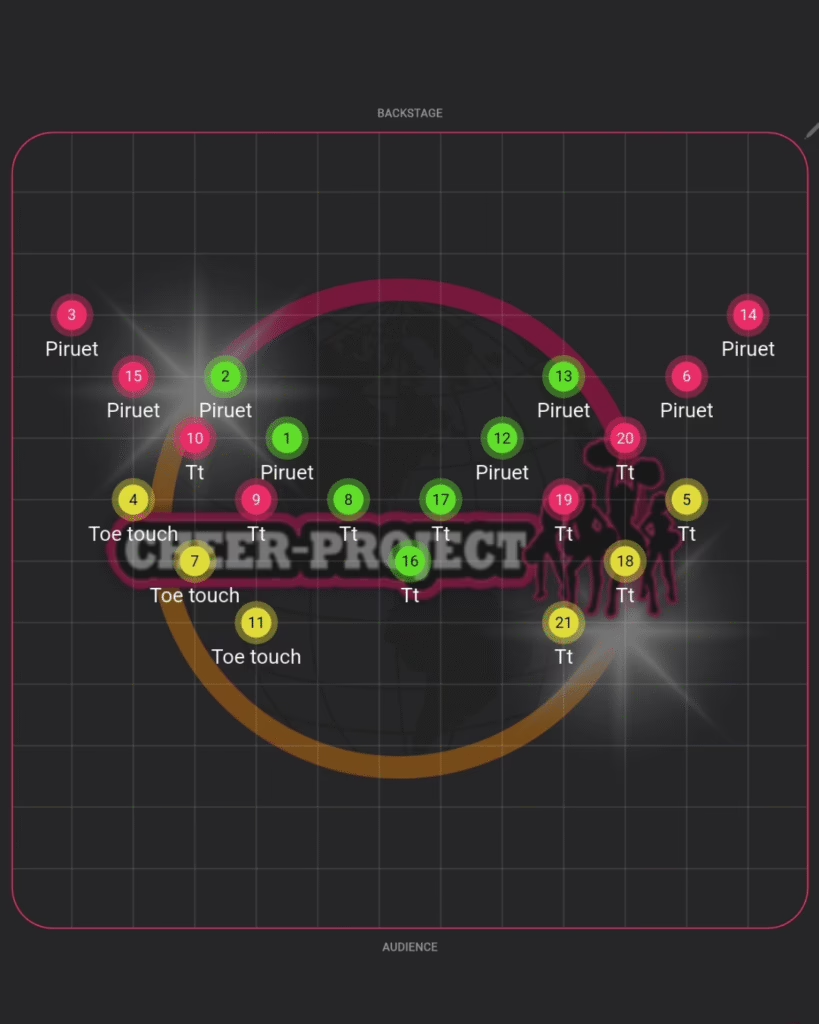
Wykorzystanie (zagospodarowanie) parkietu oraz efekty wizualne w choreografii stanowią jeden komponent w karcie ocen. Dlatego przeczytaj wpis: Ustawienia w choreografiach performance cheer.
Co dokładnie mówi karta ocen? Że w tym miejscu oceniane jest jak drużyna zagospodarowuje parkiet POPRZEZ liczne formacje (ustawienia) i “niewidoczne” przejścia, a także efekty wizualne poczytane jako praca w grupach, partnerowania, zejścia na podłogę, podnoszenia, praca na poziomach i opozycjach (odbicie lustrzane) i tym podobne.
Co ważne, te wyżej wymienione elementy można stosować w tym samym czasie!
Formacje, ustawienia w cheerleadingu
Czy jest jedna metoda na najlepsze ustawienia? Oczywiście, że nie, ale jest kilka sposobów, aby był one efektywne, a przy okazji efektowne.
Po pierwsze, pamiętajmy, że nasz mózg kocha symetrię. Czy to oznacza, że wszystkie ustawienia muszą być symetryczne? Nie, jeśli ma to uzasadnienie w choreografii. To samo tyczy się przestrzeni między zawodnikami. Kochamy, kiedy są one równe!
Choreografia ma zaskakiwać, więc też nie bójmy się próbować nowatorskich rozwiązań.
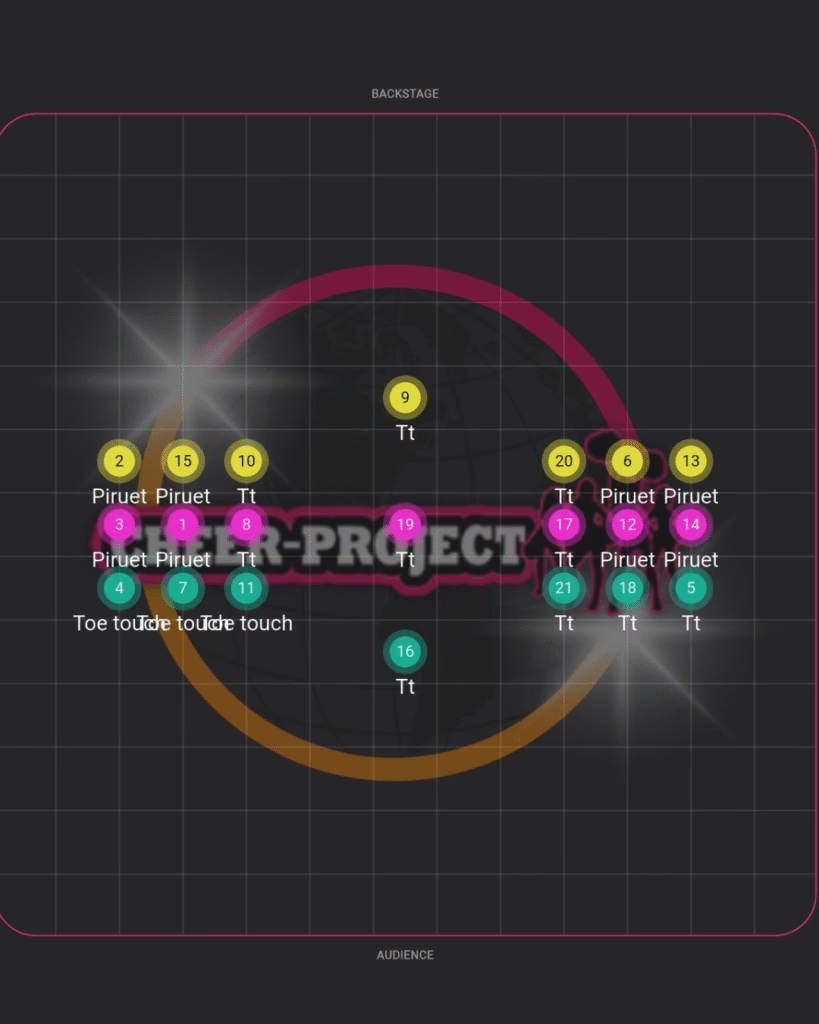
Po drugie, pamiętajmy, że w cheerleadingu nie mamy liderów. Dlatego też, widoczne trzymanie niektórych zawodników z tyłu przez całą choreografię, nie wpływa dobrze na jej sędziowski odbiór. Sędziowie wiedzą, że najczęściej z tyłu trener sytuuje zawodników początkujących lub z mniejszymi umiejętnościami…. to właśnie dlatego tam sędziowie patrzą. Tutaj się nic nie ukryje.
Trenerzy muszą rotować zawodnikami, przez całą choreografię. Dlatego sprytnym rozwiązaniem jest tak zmieniać ustawienia, że na jakiś prostszy fragment choreografii Ci początkujący zawodnicy są przeniesieni do przodu.
Zmiany ustawień
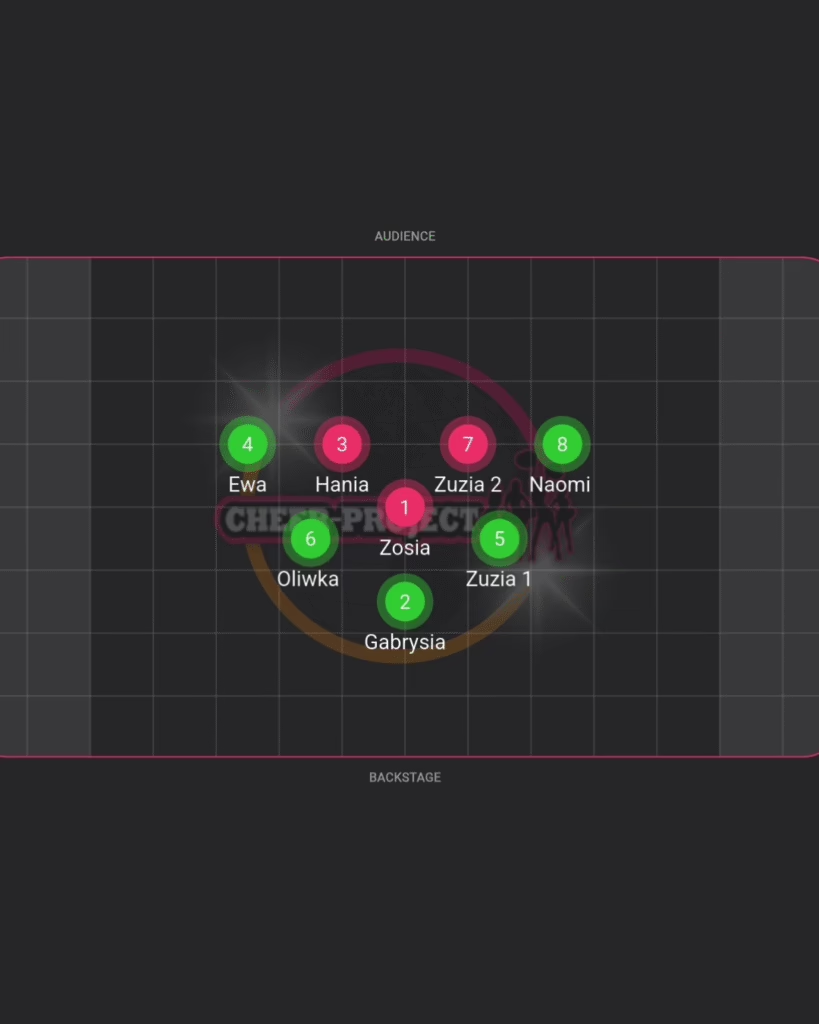
Zmiany ustawień, czyli tranzycje albo przejścia, to duży element widowiskowości choreografii. Już dawno skończyły się czasy chaotycznego biegania od ustawienia do ustawienia.
Teraz zmiany ustawień mają być częścią choreografii (tak, tak teoretycznie od zawsze są), w ten sposób, że wykorzystujemy je przy efektach wizualnych. Używamy różnych ustawień pom, wykorzystujemy różne metody przemieszczania się jak marsz, elementy akrobatyczne, przetoczenia ect.
Zmiana ustawień sama w sobie powinna być niewidoczna np. poprzez wiele efektów, że nowe ustawienie jest zaskoczeniem dla widza. Tak, brzmi to skomplikowanie i może na pierwszy rzut oka sprzecznie, ale to tylko dlatego, że możliwości jest ogrom i tylko od choreografów zależy, które opcje zostaną wykorzystane. A że zmian ustawień musi być sporo, to można wykorzystać bardzo wiele z tych pomysłów.
Jak zatem sprawić, aby zmiany ustawień były tzw “seemless”, czy takie niewidoczne ale skuteczne? Po pierwsze, pracuj w sektorach. Jak przyjrzysz się poszczególnym zawodnikom najlepszych drużyn, to większe fragmenty choreografii spędzają w jednym sektorze. Nie biegają non stop z prawej na lewą stronę. Zmiany ustawień, często wyglądają tak, że każdy zawodnik wykonuje 2-4 kroki w różne kierunki i już mamy gotowe, nowe ustawienie.
Warto tutaj przypomnieć o symetrii i o tym, że odległości między zawodnikami w trakcie zmiany ustawienia powinny być równe.
Ile powinno być zmian ustawień w choreografii?
Jednoznacznej odpowiedzi nie ma, ale warto wiedzieć, że:
1. Nie ilość a jakość. Jeśli mocną stroną Twoich zawodników nie są zmiany ustawień, to wykorzystaj ich mniej i to o wiele prostsze.
2. Pamiętaj, że dwom krokami jesteś w stanie zmienić ustawienie całej formacji, zatem wykorzystaj wiele szans. Liczy się to, jak często te ustawienia zmieniasz!
LIFEHACK! Jeśli zawodnik MUSI pokonać długą drogę w choreografii, podziel ją na kilka mniejszych zmian ustawień, dzięki temu mniej będzie widoczny ten bieg jednego zawodnika
Zagospodarowanie parkietu- Ustawienia w choreografiach performance cheer
Tutaj sytuacja wygląda nieco inaczej. Sędziowie chcą zobaczyć czy drużyna przemieszcza się po całym parkiecie, czy tylko zmienia ustawienia w jego centrum. Ważne jest, aby usytuować drużynę w jak największej ilości miejsc na parkiecie. Oczywiście, zmiana miejsca na parkiecie, może też być też połączona ze zmianą ustawienia.
Zagospodarowanie parkietu przedstawiają poniższe rysunki, które obrazują to samo ustawienie, ale w różnych miejscach parkietu. Jest to tez rozwiązanie dla drużyn, których mocną stroną nie są zmiany ustawień, i w tej sytuacji mogą pomóc przemieszczenia całych drużyn w tym samum ustawieniu.
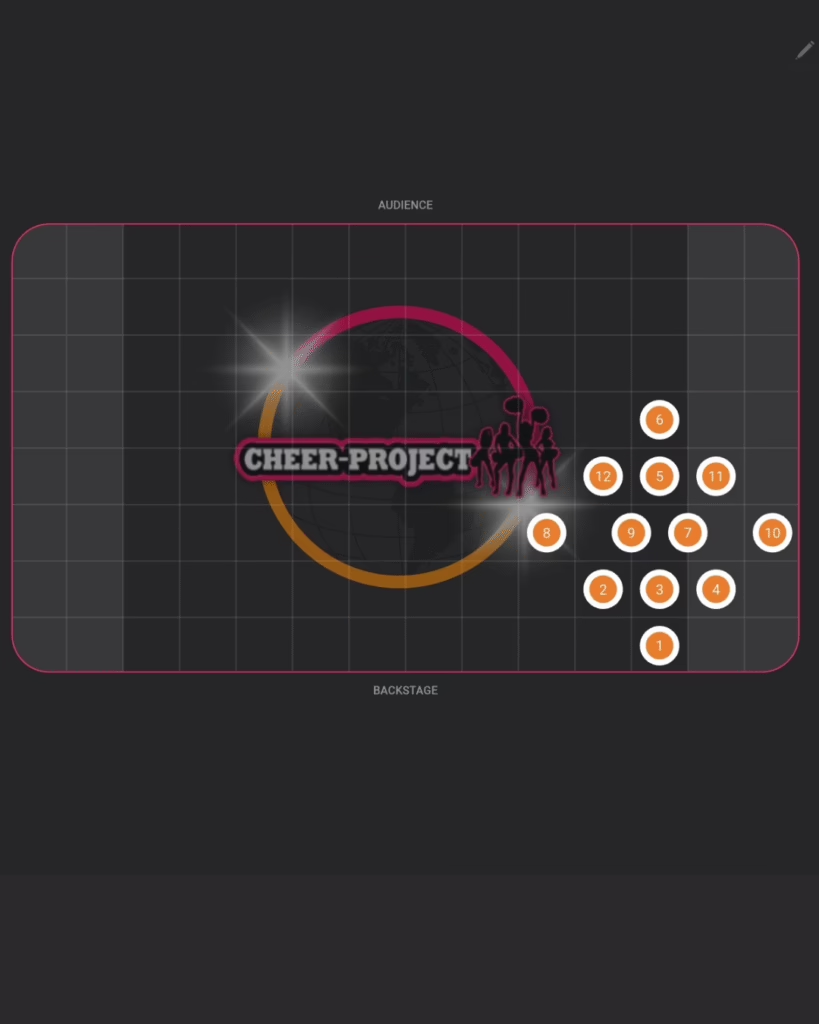
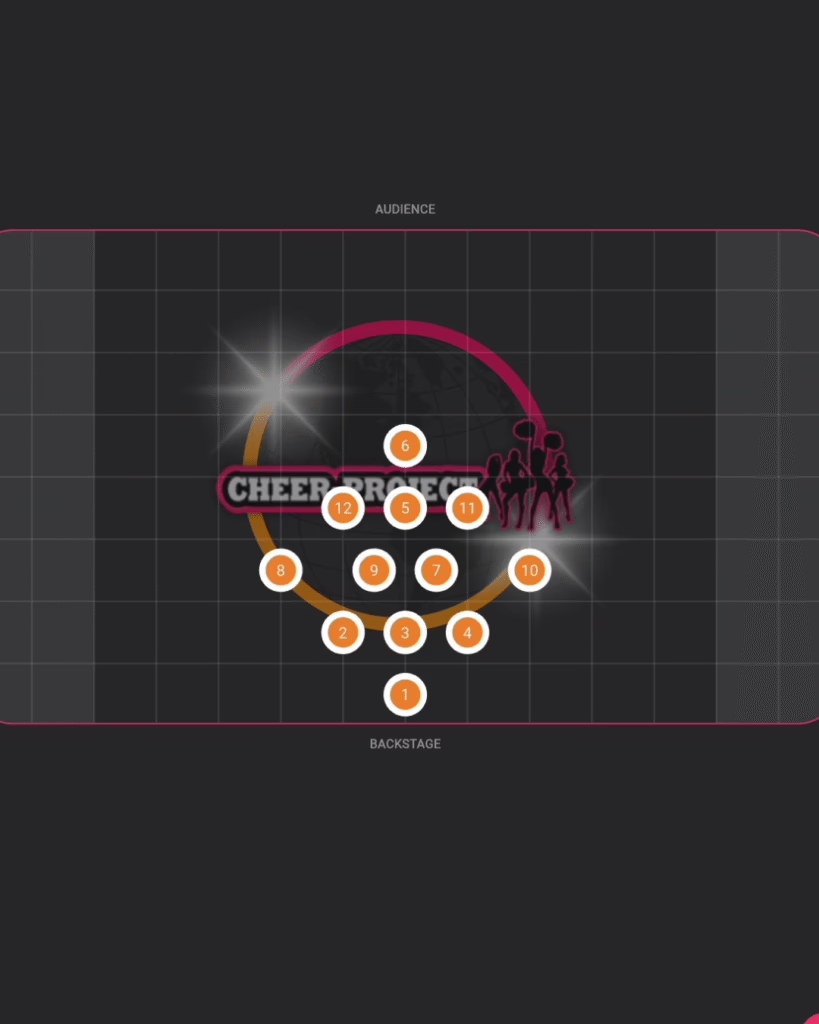
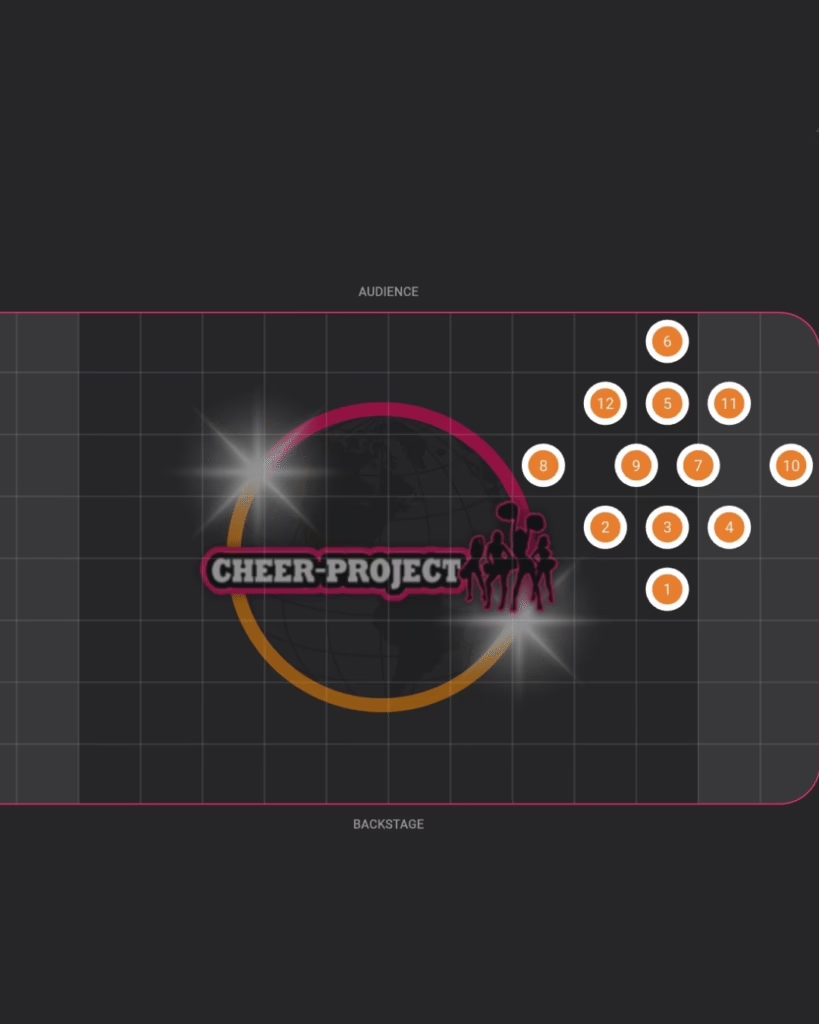
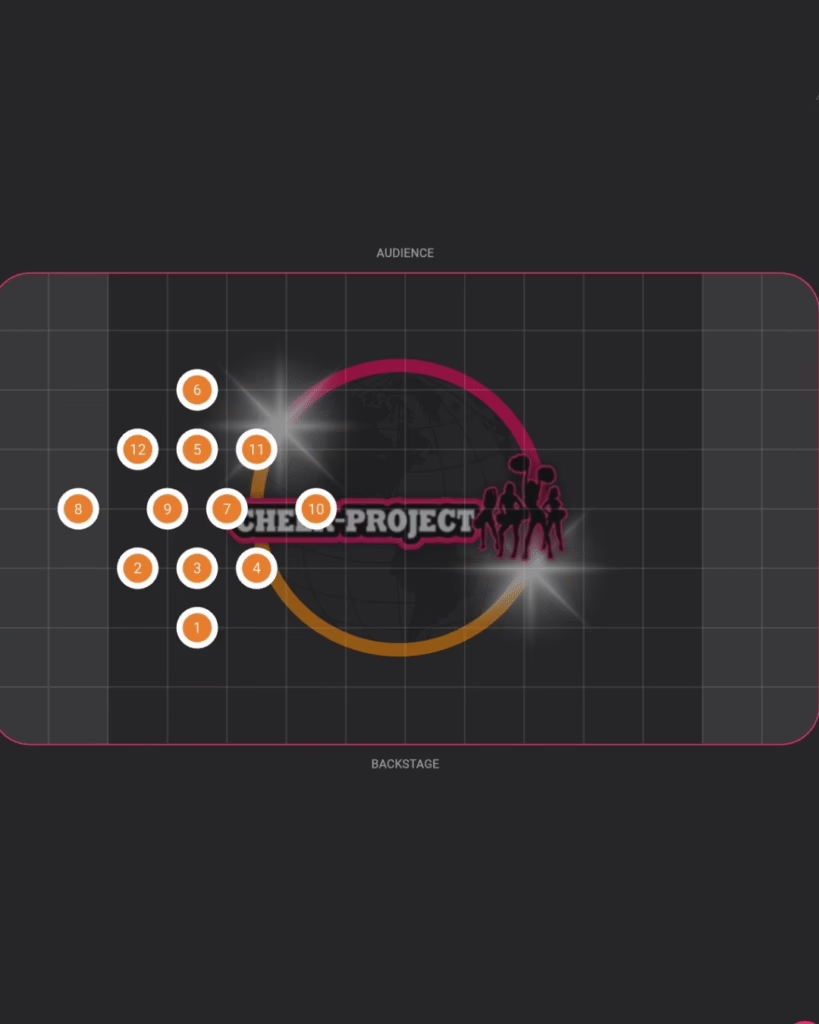
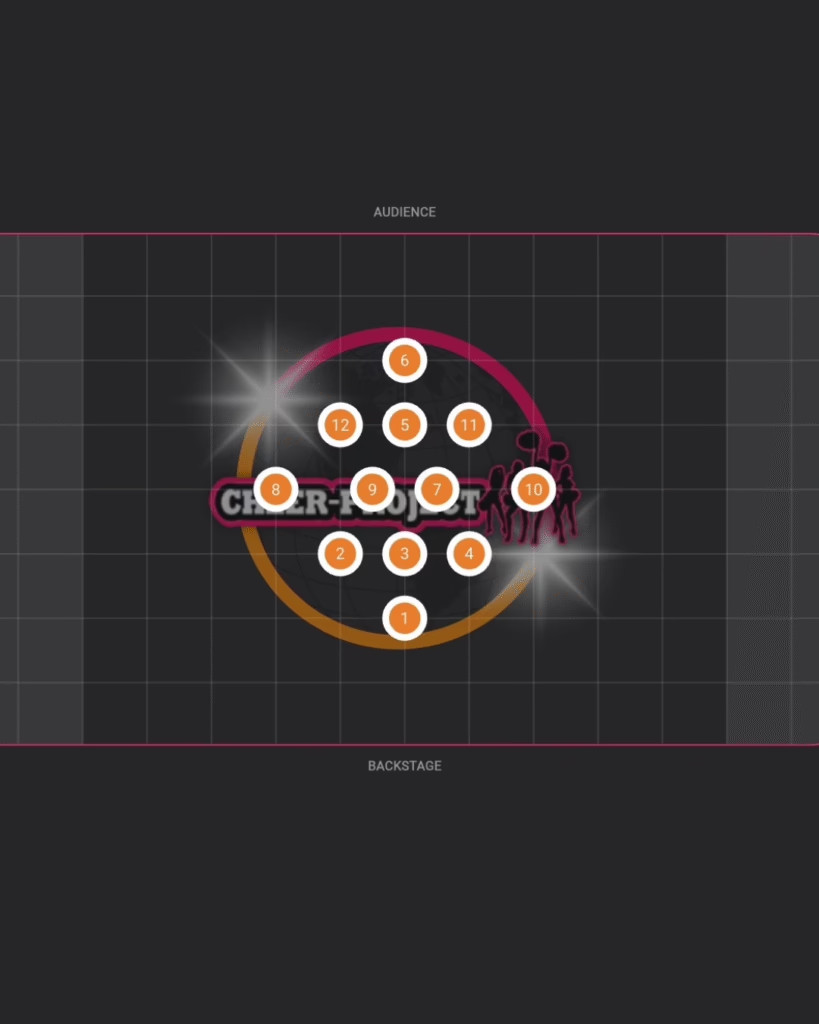
Potrzebujesz więcej informacji? Dołącz do nas na szkoleniach!
#english

The use (management) of the dance floor and visual effects in choreography is one component of the scoresheet.
What exactly does the scoresheet say? It states that this section scores how the team uses the dance floor THROUGH numerous formations (“settings”) and “ unseen” transitions, as well as visual effects considered as group work, partnerwork, floor work, lifts, work on levels and oppositions (mirroring), and the like.
Importantly, the above-mentioned elements can be used at the same time!
Formations in cheerleading
Is there one method for the best formations? Of course not, but there are several ways to make them effective and, at the same time, spectacular.
First, remember that our brain loves symmetry. Does this mean that all formations must be symmetrical? No, if it is reasonable in terms of choreography. The same applies to the space between athletes. We love it when they are equal!
Choreography is meant to surprise, so don’t be afraid to try innovative solutions.

Secondly, let’s remember that there are no leaders (main athletes) in cheerleading. Therefore, visibly keeping some athletes in the back throughout the entire choreography does not have a positive effect on the judges’ perception. The judges know that the coach usually places beginners or less skilled athletes in the back…. which is why the judges look there. Nothing can be hidden here.
Coaches must rotate the athletes throughout the choreography. Therefore, a smart solution is to change the formation so that the beginner athletes are moved to the front for a simpler part of the choreography.
Transitions/Formation changes in performance cheer

Changes in formation, i.e., transitions, are a major element of choreography’s visuals effects. The days of chaotic running from one position to another are long gone.
Now, changes in formations are supposed to be part of the choreography (yes, yes, theoretically they always have been), in such a way that we use them for visual effects. We use different pom positions, we use different methods of movement such as walking, acrobatic elements, sit rolls, etc.
The change in formations should be invisible in itself, e.g., through multiple effects, so that the new formation comes as a surprise to the spectator. Yes, it sounds complicated and may seem contradictory at first glance, but that’s only because the possibilities are endless and it’s up to the choreographers to decide which options to use. And since there have to be a lot of changes to the formations, many of these ideas can be used.
So how can you make changes to the formations seamless, invisible but effective? First, work in sectors. If you look at individual athletes from the best teams, they spend most of the choreography in one sector. They don’t run non-stop from right to left. Changes in transitions often look like this: each player takes 2-4 steps in different directions and the new formation is ready.
It is worth remembering here about symmetry and the fact that the distances between athletes during a transition should be equal.
How many formations and transitions should choreography contain?
There is no clear answer, but it is worth knowing that:
- It’s not quantity but quality. If changing formations is not your athletes’ strong point, use them less often and make them much simpler.
- Remember that you can change the entire formation with just two steps, so take advantage of multiple opportunities. What matters is how often you change these formations!
LIFEHACK! If an athlete MUST cover a long distance in the choreography, divide it into several smaller changes of formation, so that the run of one athlete will be less noticeable.
Usage of the floor in perfomance cheer
Here, the situation is slightly different. Judges want to see whether the team moves around the entire floor or only changes its formation in the centre of the floor. It is important to place the team in as many places on the floor as possible. Of course, changing places on the floor can also be combined with a change in formation.
The use of the floor is shown in the drawings below, which illustrate the same formation but in different locations on the floor. This is also a solution for teams whose strength is not changing formations, and in this situation, moving entire teams in the same formation can help.





Do you need more information? Do you need workshops or clinics? Let us know! We are open to work internationally
